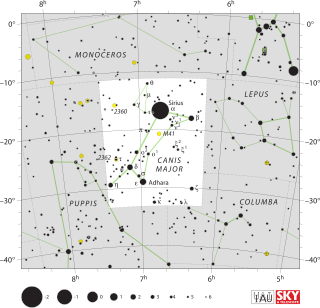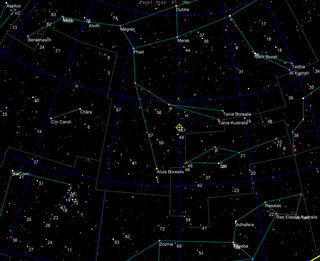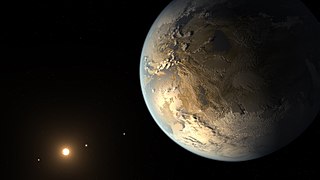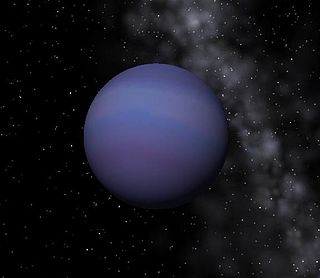
Canis Major is a constellation in the southern celestial hemisphere. In the second century, it was included in Ptolemy's 48 constellations, and is counted among the 88 modern constellations. Its name is Latin for "greater dog" in contrast to Canis Minor, the "lesser dog"; both figures are commonly represented as following the constellation of Orion the hunter through the sky. The Milky Way passes through Canis Major and several open clusters lie within its borders, most notably M41.

An exoplanet or extrasolar planet is a planet outside the Solar System. The first possible evidence of an exoplanet was noted in 1917 but was not recognized as such. The first confirmation of the detection occurred in 1992. A different planet, initially detected in 1988, was confirmed in 2003. As of 1 December 2023, there are 5,550 confirmed exoplanets in 4,089 planetary systems, with 887 systems having more than one planet. The James Webb Space Telescope (JWST) is expected to discover more exoplanets, and also much more about exoplanets, including composition, environmental conditions and potential for life.
14 Herculis or 14 Her is the Flamsteed designation of a K-type main-sequence star 58.4 light-years away in the constellation Hercules. It is also known as HD 145675. Because of its apparent magnitude, the star cannot be seen with the naked eye. As of 2021, 14 Herculis is known to host two exoplanets in orbit around the star.

47 Ursae Majoris, formally named Chalawan, is a yellow dwarf star approximately 45.3 light-years from Earth in the constellation of Ursa Major. As of 2011, three extrasolar planets are believed to orbit the star.

Epsilon Canis Majoris is a binary star system and the second-brightest object in the constellation of Canis Major. Its name is a Bayer designation that is Latinised from ε Canis Majoris, and abbreviated Epsilon CMa or ε CMa. This is the 22nd-brightest star in the night sky with an apparent magnitude of 1.50. About 4.7 million years ago, it was the brightest star in the night sky, with an apparent magnitude of −3.99. Based upon parallax measurements obtained during the Hipparcos mission, it is about 430 light-years distant from the Sun.

Nu2 Canis Majoris (ν2 Canis Majoris) is a single star in the southern constellation of Canis Major. It is a cool giant with two confirmed exoplanets.
Nu3 Canis Majoris, Latinized from ν3 Canis Majoris, is a binary star system in the southern constellation of Canis Major.

These are lists of exoplanets. As of 30 November 2023, there are 5,550 confirmed exoplanets in 4,130 planetary systems, with 940 systems having more than one planet. Most of these were discovered by the Kepler space telescope. There are an additional 1,984 potential exoplanets from Kepler's first mission yet to be confirmed, as well as 977 from its "Second Light" mission and 4,632 from the Transiting Exoplanet Survey Satellite (TESS) mission.

47 Ursae Majoris b, formally named Taphao Thong, is a gas planet and an extrasolar planet approximately 46 light-years from Earth in the constellation of Ursa Major. The planet was discovered located in a long-period orbit around the star 47 Ursae Majoris in January 1996 and as of 2011 it is the innermost of three known planets in its planetary system. It has a mass at least 2.53 times that of Jupiter.

47 Ursae Majoris c, formally named Taphao Kaew is an extrasolar planet approximately 46 light-years from Earth in the constellation of Ursa Major. The planet was discovered located in a long-period around the star 47 Ursae Majoris. Its orbit lasts 6.55 years and the planet has a mass at least 0.540 times that of Jupiter.

Epsilon Eridani b, also known as AEgir [sic], is an exoplanet approximately 10.5 light-years away orbiting the star Epsilon Eridani, in the constellation of Eridanus. The planet was discovered in 2000, and as of 2023 remains the only confirmed planet in its planetary system. It orbits at around 3.5 AU with a period of around 7.6 years, and has a mass around 0.6 times that of Jupiter. As of 2023, both the Extrasolar Planets Encyclopaedia and the NASA Exoplanet Archive list the planet as 'confirmed'.
14 Herculis c or 14 Her c is an exoplanet approximately 58.4 light-years away in the constellation of Hercules. The planet was found orbiting the star 14 Herculis, with a mass that would make the planet a gas giant roughly the same size as Jupiter but much more massive. It was discovered on November 17, 2005 and published on November 2, 2006, although its existence was not confirmed until 2021.

Gliese 86 b, sometimes referred to as Gliese 86 A b and/or shortened to Gl 86 b, is an extrasolar planet approximately 35 light-years away in the constellation of Eridanus. The planet was discovered orbiting a K-type main-sequence star by French scientists in November 1998. The planet orbits very close to the star, completing an orbit in 15.78 days.
HD 154857 c is an extrasolar planet located approximately 224 light-years away in the constellation of Ara, orbiting the star HD 154857. This planet takes about 3470 days to orbit the star.
Gliese 832 b is a gas giant exoplanet about 80% the mass of Jupiter, located 16.2 light-years from the Sun in the constellation of Grus, orbiting the red dwarf star Gliese 832.

An exoplanet is a planet located outside the Solar System. The first evidence of an exoplanet was noted as early as 1917, but was not recognized as such until 2016; no planet discovery has yet come from that evidence. What turned out to be the first detection of an exoplanet was published among a list of possible candidates in 1988, though not confirmed until 2003. The first confirmed detection came in 1992, with the discovery of terrestrial-mass planets orbiting the pulsar PSR B1257+12. The first confirmation of an exoplanet orbiting a main-sequence star was made in 1995, when a giant planet was found in a four-day orbit around the nearby star 51 Pegasi. Some exoplanets have been imaged directly by telescopes, but the vast majority have been detected through indirect methods, such as the transit method and the radial-velocity method. As of 1 December 2023, there are 5,550 confirmed exoplanets in 4,089 planetary systems, with 887 systems having more than one planet. This is a list of the most notable discoveries.
Doctor Robert A. Wittenmyer is an American-Born in Australian astrophysicist and astronomer. He has led the team of researchers who discovered the exoplanet Gliese 832 c. He is the leader of a collaboration between Australian, Chinese, and the US exoplanet search team and also a member of the Anglo-Australian Planet Search. He is currently employed by the University of Southern Queensland located in Toowoomba, Queensland, Australia as an Associate Professor.

OGLE-2007-BLG-349(AB)b is a circumbinary extrasolar planet about 8,000 light-years away in the constellation of Sagittarius. It is the first circumbinary exoplanet to be discovered using the microlensing method of detecting exoplanets.











